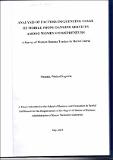| dc.description.abstract | Since the launch of M-Pesa by Safaricom service provider, Mobile banking became a reality in Kenya. The service enables subscribers to use their mobile phones to carry out transactions such as pay for goods and services, pay bills, send to and receive money from friends and family, withdraw cash for their use, top up their own airtime account or top up someone else's account and manage their own accounts. M-Pesa too paved the way for other network service providers to offer mobile- banking services such as Airtel money, Yu cash and orange money which also offer the same services as M-Pesa. However, there is laxity among women entrepreneurs in the adoption of mobile banking services in that they prefer cash transactions to e-cash payments in their day to day transactions. Against the backdrop of this laxity, the following factors were analyzed: social cultural practices, security, ease of accessibility, low .costs of transactions and finally the support from the network service providers. The study applied the Theory of Technology Acceptance Model (TAM) to help predict factors affecting the usage of mobile banking services among women banana traders. The research survey was carried out around three major banana trading centers in Meru central within Meru County. This banana trading centers were selected from an array of many but preferred due to their proximity and accessibility. They were Kariene, Miruriri and Mwichiune. It was assumed also that the women banana traders at these centers were likely to be using mobile phone banking services. The research design was a descriptive survey that was conducted through administration of questionnaires. Primary data was collected using closed ended questionnaires. The total population of the research survey was 200 respondents which comprised women banana traders in the three banana trading spots. Convenient sampling was used to select respondents from the three banana trading spots. An estimated 25% of the total population was selected at each banana trading spot to arrive at the sample size of 50 respondents around banana market spots in Meru central. Descriptive statistics was used to analyze data aided by SPSS (version 20) using Multiple Logistic Regression model to link the relationship between the independent and dependent variables and to test the hypothesis at 5% significance level. Analyzes of the data revealed that social cultural practices of the money transfer technology enshrined in family ties, remittances and informal groups plus its accessibility, cost; support and security factors are related to behavioral intention to use and actual usage of the mobile banking services by the women banana traders. The research findings helped add to the scanty literature on usage of mobile phone banking services and recommended that further research be undertaken to investigate the impact of the actual usage of the mobile phone banking services on the
growth and success of the business. | en_US |

